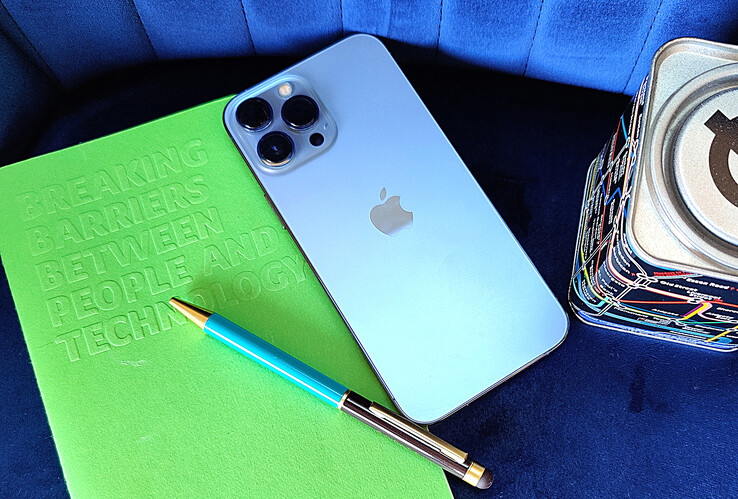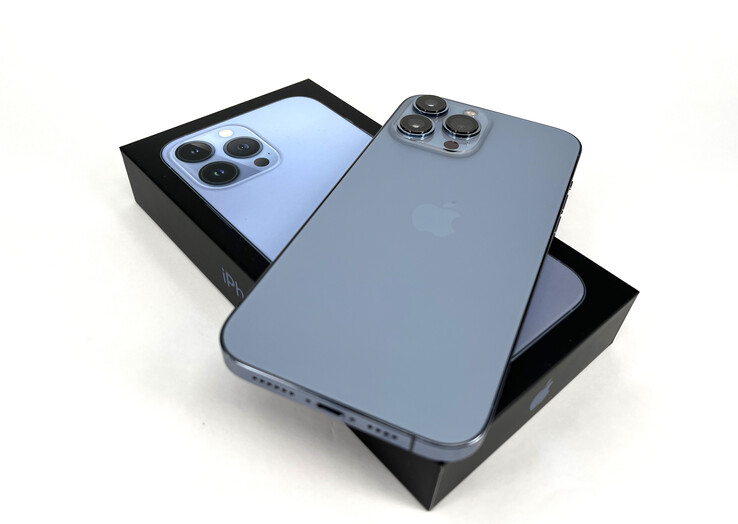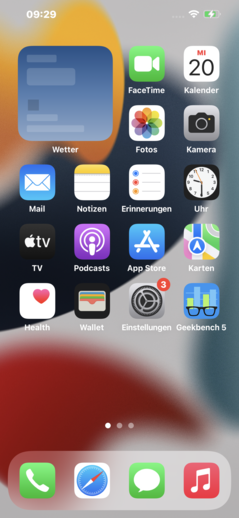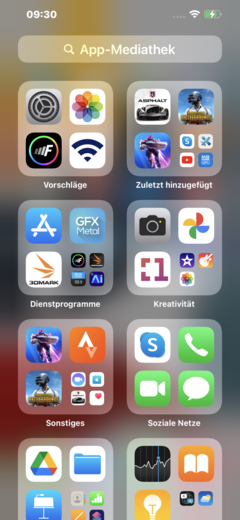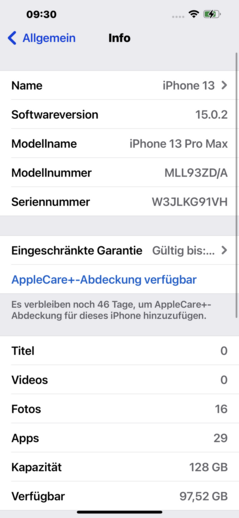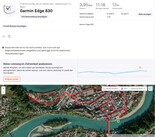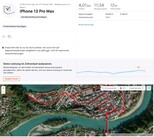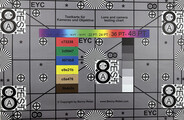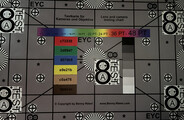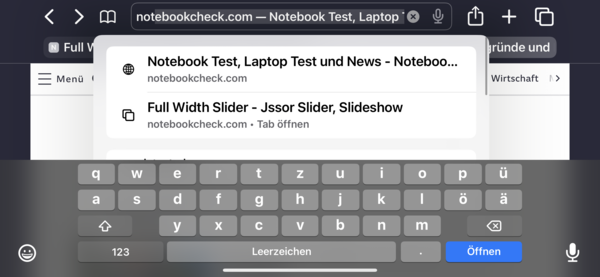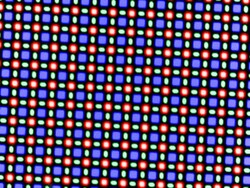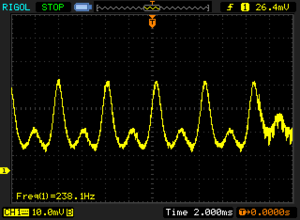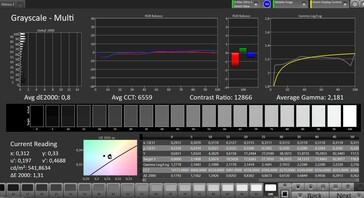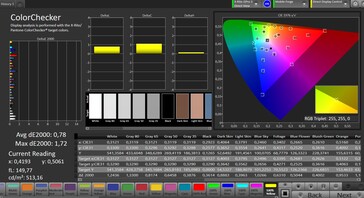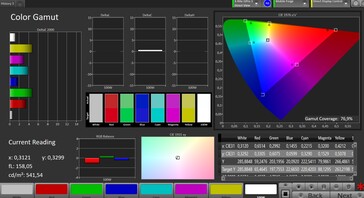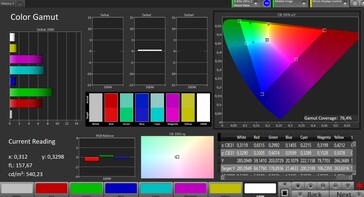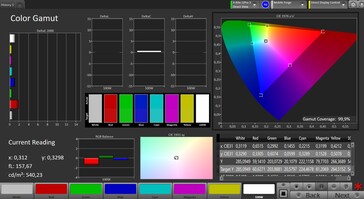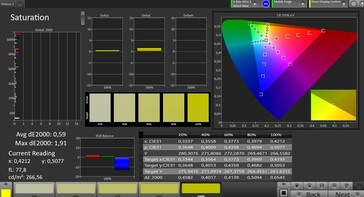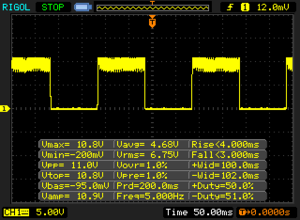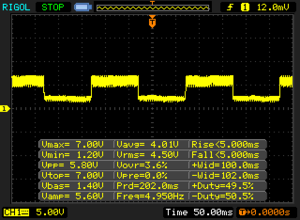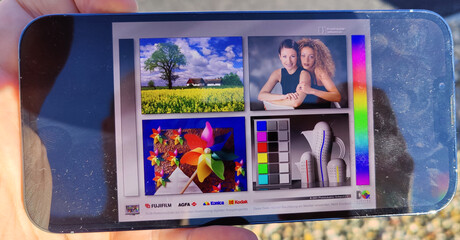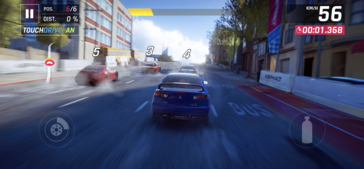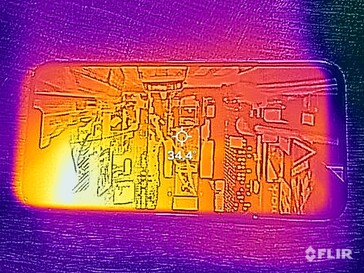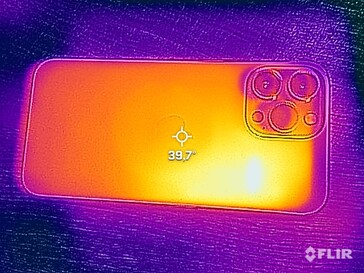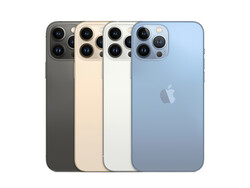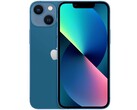Apple iPhone 13 Pro Max smartphone review – Powerful, large, and full of features
More iPhone than the iPhone 13 Pro Max is currently impossible. Apple's largest smartphone from the 2021 generation brings everything in terms of new technologies the Californians could think of. The Apple smartphone includes a huge 120-Hz display with a 6.7-inch diagonal, one of the fastest SoCs that is available at the time of this test, and up to 1 TB of storage space.
While Apple's top model is of course not very affordable, we take a detailed look whether it is worth its price.
Possible Competitors in Comparison
Rating | Date | Model | Weight | Drive | Size | Resolution | Price |
|---|---|---|---|---|---|---|---|
| 90.5 % v7 (old) | 10 / 2021 | Apple iPhone 13 Pro Max A15, A15 GPU 5-Core | 238 g | 128 GB NVMe | 6.70" | 2778x1284 | |
| 88.7 % v7 (old) | 12 / 2020 | Apple iPhone 12 Pro Max A14, A14 Bionic GPU | 228 g | 128 GB NVMe | 6.70" | 2778x1284 | |
| 90.4 % v7 (old) | 02 / 2021 | Samsung Galaxy S21 Ultra Exynos 2100 5G, Mali-G78 MP14 | 227 g | 128 GB UFS 3.1 Flash | 6.80" | 3200x1440 | |
| 87.2 % v7 (old) | 07 / 2021 | Sony Xperia 1 III SD 888 5G, Adreno 660 | 186 g | 256 GB UFS 3.1 Flash | 6.50" | 3840x1644 | |
| 89.2 % v7 (old) | 06 / 2021 | Xiaomi Mi 11 Ultra SD 888 5G, Adreno 660 | 234 g | 256 GB UFS 3.1 Flash | 6.81" | 3200x1440 | |
| 88.6 % v7 (old) | 06 / 2022 | OnePlus 9 Pro SD 888 5G, Adreno 660 | 197 g | 256 GB UFS 3.1 Flash | 6.70" | 3216x1440 |
Case – With an elegant stainless steel frame
Due to its slightly wider build, the iPhone 13 Pro Max is a smartphone for large hands. With its 238 grams (~8.4 oz), it feels hefty in the hand. While this goes along with a high-quality impression, you have to be a fan of heavier phones to fully appreciate the Pro Max.
As we are used to from Apple, the material choices and workmanship are very good. The shiny stainless steel frame around the edges looks elegant but is also a first-class fingerprint magnet.
At the same time, there will hardly be anyone who uses their expensive iPhone without a case, even if it uses Apple's Ceramic Shield glass again, which survives falls fairly well. Of course this only goes up to a certain fall height, so it makes sense to get some additional protection for your expensive Apple smartphone.
On this note, the camera sticks out from the case by 2-3 mm (~0.08 - 0.12 in), so the camera lenses are fairly unprotected despite the sapphire glass being used. The bulge also means that the iPhone 13 Pro Max will wobble considerably when you try to operate it while it is lying on a table.
The notch in front continues to be large, but at least it is smaller than that of the predecessor.
The iPhone 13 Pro Max is of course also protected from harmful environment influences according to IP68. Apropos environment: Apple uses many recycled materials for its large iPhone and also publishes a detailed environment report.
Equipment – Up to 1 TB of storage in the iPhone
At this point, you can spend up to 1,829 Euros (~$2,124) on the most expensive member on the iPhone 13 family - a new record. Even though Apple left the prices for the storage variants the same compared to last year, the new option with 1 TB of storage adds a hefty premium.
In detail, the cost of the devices at their introductions is as follows:
- iPhone 13 Pro Max with 128 GB of storage: 1,249 Euros (~$1,451)
- iPhone 13 Pro Max with 256 GB of storage: 1,369 Euros (~$1,590)
- iPhone 13 Pro Max with 512 GB of storage: 1,599 Euros (~$1,857)
- iPhone 13 Pro Max with 1 TB of storage: 1,829 Euros (~$2,124)
The working memory is 6 GB again.
The iPhone 13 Pro Max is sold as dual-SIM, even though it actually only has a single physical slot for one Nano SIM. However, you can use one eSIM in parallel and thus also benefit from two different tariffs or use SIM cards from different countries.
Of course the iPhone 13 Pro Max also offers MagSafe again, the magnetic ring on the back that allows you to attach some accessories or charge the device.
Software – iOS 15 with a data security report
Apple has always used its own iOS operating system for the iPhones. If you come from Android, you first have to get used to several new things. In addition, iOS also limits some choices in order to protect the security of inexperienced users.
With iOS 15, Apple introduces numerous changes again, but they concern less the underlying structure but more the preinstalled apps, which offer a fairly extensive set of tools at no additional cost. For example, it is easier now to use FaceTime for video conferencing or streaming or listening to music together with a close one.
One extensive change is the Focus Mode, which you can activate when you have to concentrate on specific tasks and want to completely block some distractions. The new text recognition in photos is another interesting feature that allows you to copy texts from photos and immediately paste them into a document.
In terms of security, there are also some smaller improvements. For example, the iPhone now limits apps more in terms of how they deal with user data and it also automatically creates a data security report for the users.
Communication and GNSS – A really world-wide phone
WiFi 6 and 5G are of course a matter of honor for a high-end smartphone in 2021, and the large iPhone also does not disappoint here. It even goes one step further and offers quite a lot of 4G and 5G bands, allowing you to use it almost anywhere in the world.
However, for an absolute top piece of equipment, the new tri-band WiFi 6E standard together with 5G mmWave support are a must. Even though neither of these two is currently much in use, they would have helped in making the smartphone more future proof.
In combination with our Netgear Nighthawk AX12 reference router, our test unit achieves good transfer rates, but in the end there are also some high-end smartphones that are even faster. The signal quality and stability of the transfer are very good.
In the 4G net, the smartphone also shows a good signal quality even indoors. With this, it is at the level of other high-end smartphones.
When you step outdoors, the location is determined fairly quickly with an accuracy of up to 3 meters (~10 ft). In terms of satellite networks, GPS, A-GPS, GLONASS, and Galileo are used.
In our practical test, we go for a bike ride, comparing the large iPhone with the Garmin Edge 830 professional navigation device. The Apple smartphone does very well here, locating us accurately even in some small alleyways. There are some smaller deviations when crossing the bridge.
Telephone Functions and Voice Quality – A slightly quiet earpiece
The earpiece of the iPhone 13 Pro Max is sufficiently loud for everyday operation. However, when there is a lot happening in your surroundings, it can become difficult at times to understand your conversation partner, even at maximum volume. The microphone also records our voice well, when we speak quietly.
Via speaker phone, you also get a voice reproduction that is easily understandable but probably too quiet in noisy surroundings using the speaker. Our own voice is transferred clearly to our conversation partner here as well.
Cameras – Very bright and with strong colors
At first glance, there are no changes in the camera equipment compared to the older iPhone Pro Max models, but Apple has made multiple smaller refinements. For example, according to the specifications, the manufacturer uses new sensors, and the aperture numbers in the main and wide-angle lenses have also dropped significantly. On the other hand, the tele lens now has an aperture that is even further closed than in the iPhone 12 Pro Max, so it initially records even less light. But there is now a 3x zoom with the tele lens, and the option to zoom in or out in small steps between the three lenses now also results in a 6x zoom overall.
While there were still some differences to the smaller Pro model in the previous generation, the iPhone 13 Pro and Pro Max have exactly the same camera equipment.
The 12-Megapixel main camera takes really good pictures in daylight that offer strong colors, and the details are also very exact within the focal range. On the other hand, the evening ambiance is captured better by the automatics of the OnePlus 9 Pro and the SLR camera, whereas the iPhone probably tries to get the picture as bright as possible. Under very little light and with high contrasts, the iPhone 13 Pro Max scores with a good illumination and many details.
The wide-angle lens also takes very sharp pictures with punchy colors, but details that are further away also continue to be hardly recognizable.
8K video recording is not supported, either. On the other hand, there is a complete workflow for 4K videos beginning with the recording and up to cutting them in Apple's ProRes professional codec. However, here you should be aware of the limitations of the 128 GB model, which is only able to record 1080p ProRes video at up to 30fps.
While you can use all the cameras on the back to record a video, Apple is cheating here. Most of the time, there is no switching between the cameras, and the device selects the best lens before making the recording. This means that it could possibly only use the digital zoom of the ultra wide-angle lens, for example, which would of course limit the quality of the recordings. Or if the recording was started using the main lens, you cannot use the wide-angle lens during the recording.
It continues to be the case that those who prefer to adjust all the parameters for their pictures themselves should avoid using Apple's inhouse camera app, since that is focused mainly on automatic functions that allow anyone to take decent pictures. For professionals it is therefore recommended to try out some of the numerous other camera apps in the App Store.
Image comparison
Choose a scene and navigate within the first image. One click changes the position on touchscreens. One click on the zoomed-in image opens the original in a new window. The first image shows the scaled photograph of the test device.
Hauptkamera BlumeHauptkamera UmgebungHauptkamera Low LightWeitwinkelkameraIn the controlled light conditions of the studio, the test chart appears very sharp and the colors look strong. At an illumination of only 1 Lux, the object is brightened well, but areas appear spotty.
In good light conditions, the color reproduction is clearly too bright, which we already noticed in the pictures of the surroundings.
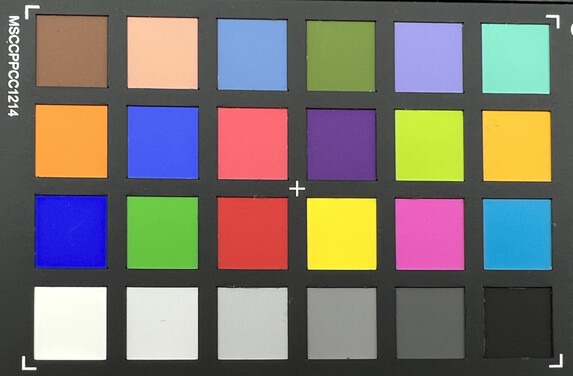
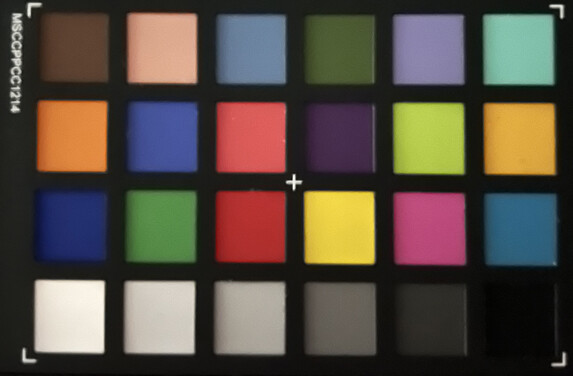
Accessories and Warranty – An extensive market of accessories
The box of the iPhone 13 Pro Max is very slim, and indeed we only find the device itself, a USB-C-to-Lightning cable, a SIM tool, and some paperwork inside. You have to purchase the charger from Apple for an extra 25 Euros (~$29). Apple says that it wants to help the environment with this, since many users already have a charger at home. But of course the company also saves a lot of money by not including a charger with the phone.
Due to the fact that there are only relatively few models available at the same time, the market for iPhone accessories is gigantic. Third party manufacturers offer any accessories you can think of, starting from additional lenses to put on top of the camera, continuing with iPhone holders for your bicycle and special drones that can hold your iPhone, and up to crazy covers in the shape of a chocolate bar.
Apple's own offerings range from the corresponding covers with MagSafe in numerous colors for 55 Euros (~$64) up to a MagSafe charger for 45 Euros (~$52) or a magnetic card holder for 65 Euros (~$75), for example.
You only get a 12-month warranty from the manufacturer, but many European countries also require a 24-month vendor warranty for the customers. Those who want to expand their warranty can do this by purchasing some special smartphone insurances, such as AppleCare+ offered by Apple itself. However, Apple's offer still only covers one year and only protects from accidental damage. In addition, you continue to have to pay a deductible.
Input Devices and Operation – FaceID with support for infrared
The touchscreen responds very accurately and quickly to inputs. Thanks to the new ProMotion technology, which is the name of the adaptive 120 Hz refresh rate, it can also be operated very smoothly.
The smartphone can be unlocked using Apple's FaceID, which is a type of face recognition that is supported in front by an infrared and depth sensor and is considered very secure. However, it is a little bit annoying, that FaceID only works if you hold the smartphone in portrait orientation.
Display – Introduction of ProMotion
Together with the iPhone 13 Pro, the Apple iPhone 13 Pro Max is one of the first Apple smartphones to feature ProMotion. This is an adaptive refresh rate that is adjusted by the system between 10 Hz (for example when reading a static document) and 120 Hz (fast scrolling) depending on the usage scenario. However, this also means that the user cannot adjust the refresh rate.
At 2,778 x 1,284 pixels, the resolution is slightly higher than that of the iPhone 13 Pro to make up for the larger display and still end up at about the same pixel density per inch. The Super Retina XDR display is an OLED panel that is certified for HDR and Dolby Vision.
In terms of brightness, it does similarly well as the display in the iPhone 13 Pro. At more than 1,000 cd/m² when necessary, it also achieves a very high brightness in larger areas, and with the OLED technology it is also able to display an almost completely black color.
| |||||||||||||||||||||||||
Brightness Distribution: 98 %
Center on Battery: 1049 cd/m²
Contrast: ∞:1 (Black: 0 cd/m²)
ΔE ColorChecker Calman: 0.78 | ∀{0.5-29.43 Ø4.77}
ΔE Greyscale Calman: 0.8 | ∀{0.09-98 Ø5}
99.9% sRGB (Calman 2D)
Gamma: 2.181
CCT: 6559 K
| Apple iPhone 13 Pro Max OLED, 2778x1284, 6.7" | Apple iPhone 12 Pro Max OLED, 2778x1284, 6.7" | Samsung Galaxy S21 Ultra Dynamic AMOLED 2X, 3200x1440, 6.8" | Sony Xperia 1 III OLED, 3840x1644, 6.5" | Xiaomi Mi 11 Ultra AMOLED, 3200x1440, 6.8" | OnePlus 9 Pro AMOLED, 3216x1440, 6.7" | |
|---|---|---|---|---|---|---|
| Screen | -33% | -73% | -266% | -59% | -36% | |
| Brightness middle (cd/m²) | 1049 | 855 -18% | 910 -13% | 537 -49% | 891 -15% | 733 -30% |
| Brightness (cd/m²) | 1060 | 857 -19% | 913 -14% | 539 -49% | 888 -16% | 746 -30% |
| Brightness Distribution (%) | 98 | 98 0% | 98 0% | 95 -3% | 99 1% | 97 -1% |
| Black Level * (cd/m²) | ||||||
| Colorchecker dE 2000 * | 0.78 | 1.1 -41% | 2 -156% | 4.78 -513% | 1.9 -144% | 0.95 -22% |
| Colorchecker dE 2000 max. * | 1.72 | 2.51 -46% | 3.1 -80% | 7.83 -355% | 3.7 -115% | 2.01 -17% |
| Greyscale dE 2000 * | 0.8 | 1.4 -75% | 2.2 -175% | 5.8 -625% | 1.3 -63% | 1.7 -113% |
| Gamma | 2.181 101% | 2.187 101% | 2.06 107% | 2.363 93% | 2.3 96% | 2.21 100% |
| CCT | 6559 99% | 6337 103% | 6512 100% | 7982 81% | 6527 100% | 6591 99% |
* ... smaller is better
Screen Flickering / PWM (Pulse-Width Modulation)
| Screen flickering / PWM detected | 238.1 Hz | ||
The display backlight flickers at 238.1 Hz (worst case, e.g., utilizing PWM) . The frequency of 238.1 Hz is relatively low, so sensitive users will likely notice flickering and experience eyestrain at the stated brightness setting and below. In comparison: 53 % of all tested devices do not use PWM to dim the display. If PWM was detected, an average of 8084 (minimum: 5 - maximum: 343500) Hz was measured. | |||
As usual for OLED displays, we notice a flickering. However, at the same time the amplitude flattens and the frequency drops at low brightness. This means that Apple probably integrated DC Dimming, which becomes effective at a low brightness, into its panel control. Although when in doubt, you should still try out the display before making a purchase decision, we are confident that the annoyance turns out lower than with other OLED displays without DC Dimming.
We measure the display's color accuracy with the spectral photometer and CalMAN software. Apple's display achieves very good values here, so that you can also use the display to evaluate colors in the professional area. However, to be on the safe side you should then turn off TrueTone, since that sensor adjusts the colors depending on the surrounding light.
Display Response Times
| ↔ Response Time Black to White | ||
|---|---|---|
| 7 ms ... rise ↗ and fall ↘ combined | ↗ 4 ms rise | |
| ↘ 3 ms fall | ||
| The screen shows very fast response rates in our tests and should be very well suited for fast-paced gaming. In comparison, all tested devices range from 0.1 (minimum) to 240 (maximum) ms. » 20 % of all devices are better. This means that the measured response time is better than the average of all tested devices (20.2 ms). | ||
| ↔ Response Time 50% Grey to 80% Grey | ||
| 10 ms ... rise ↗ and fall ↘ combined | ↗ 5 ms rise | |
| ↘ 5 ms fall | ||
| The screen shows good response rates in our tests, but may be too slow for competitive gamers. In comparison, all tested devices range from 0.165 (minimum) to 636 (maximum) ms. » 22 % of all devices are better. This means that the measured response time is better than the average of all tested devices (31.6 ms). | ||
Thanks to the display being very bright if necessary, the iPhone 13 Pro Max hardly has any problems even in very bright sunlight. However, the reflections of the surroundings are still strenuous for the eyes.
There are no complaints about the viewing angles, so even from very steep angles, you can still recognize the image easily.
Performance – One of the fastest smartphones
With the new Apple A15 Bionic, the iPhone 13 Pro Max also uses one of the most powerful SoCs currently on the market. In contrast to the iPad Mini, you get the full clock speed of up to 3.2 GHz, and in contrast to the iPhone 13 and iPhone 13 Mini, there is even a GPU with 5 cores, so there should be even more power in the graphics here.
In fact, the iPhone 13 Pro Max achieves top values in practically all the benchmarks. At the same time the Apple smartphone also proves itself to be lightning fast in everyday operation, even while multitasking with video overlays and demanding apps, such as for Augmented Reality or controlling drones.
| AImark - Score v2.x (sort by value) | |
| Apple iPhone 13 Pro Max | |
| Apple iPhone 12 Pro Max | |
| Samsung Galaxy S21 Ultra | |
| Xiaomi Mi 11 Ultra | |
| Average Apple A15 Bionic (104532 - 107460, n=5) | |
The Apple iPhone 13 Pro Max is also extremely fast when surfing the Internet. Most of the time, the images are already loaded when scrolling a page, and HTML 5 also hardly brings the smartphone close to its limits.
| Jetstream 2 - 2.0 Total Score | |
| Average Apple A15 Bionic (173.5 - 189.9, n=8) | |
| Apple iPhone 13 Pro Max (Safari 15) | |
| Apple iPhone 12 Pro Max (Safari 14) | |
| Average of class Smartphone (23.8 - 387, n=147, last 2 years) | |
| Xiaomi Mi 11 Ultra (Chrome91) | |
| Samsung Galaxy S21 Ultra (Chrome 88) | |
| OnePlus 9 Pro (Microsoft Edge 46) | |
| JetStream 1.1 - Total Score | |
| Apple iPhone 13 Pro Max (Safari 15) | |
| Average Apple A15 Bionic (383 - 414, n=6) | |
| Apple iPhone 12 Pro Max (Safari 14) | |
| Xiaomi Mi 11 Ultra (Chrome91) | |
| Samsung Galaxy S21 Ultra (Chrome 88) | |
| OnePlus 9 Pro (Microsoft Edge 46) | |
| Speedometer 2.0 - Result 2.0 | |
| Average Apple A15 Bionic (228 - 347, n=8) | |
| Apple iPhone 13 Pro Max (Safari 15) | |
| Average of class Smartphone (15.2 - 643, n=119, last 2 years) | |
| Apple iPhone 12 Pro Max (Safari 14) | |
| Xiaomi Mi 11 Ultra (Chrome91) | |
| Samsung Galaxy S21 Ultra (Chrome 88) | |
| OnePlus 9 Pro (Microsoft Edge 46) | |
| WebXPRT 3 - Overall | |
| Average Apple A15 Bionic (219 - 279, n=8) | |
| Apple iPhone 13 Pro Max (Safari 15) | |
| Apple iPhone 12 Pro Max (Safari 14) | |
| Average of class Smartphone (38 - 380, n=30, last 2 years) | |
| Xiaomi Mi 11 Ultra (Chrome91) | |
| Samsung Galaxy S21 Ultra (Chrome 88) | |
| OnePlus 9 Pro (Microsoft Edge 4689) | |
| Octane V2 - Total Score | |
| Apple iPhone 13 Pro Max (Safari 15) | |
| Average Apple A15 Bionic (57143 - 65969, n=8) | |
| Apple iPhone 12 Pro Max (Safari 14) | |
| Average of class Smartphone (2228 - 126661, n=194, last 2 years) | |
| Xiaomi Mi 11 Ultra (Chrome91) | |
| Samsung Galaxy S21 Ultra (Chrome 88) | |
| OnePlus 9 Pro (Microsoft Edge 46) | |
| Mozilla Kraken 1.1 - Total | |
| OnePlus 9 Pro (Microsoft Edge 46) | |
| Samsung Galaxy S21 Ultra (Chrome 88) | |
| Xiaomi Mi 11 Ultra (Chrome91) | |
| Average of class Smartphone (257 - 28190, n=154, last 2 years) | |
| Apple iPhone 12 Pro Max (Safari 14) | |
| Average Apple A15 Bionic (414 - 507, n=8) | |
| Apple iPhone 13 Pro Max (Safari 15) | |
* ... smaller is better
Games – ProMotion doesn't offer any advantage yet
The iPhone 13 Pro Max is very well-suited for gaming, but not (yet) at more than 60 fps, since most of the games have not been optimized or enabled for this.
However, in the fast Armajet shooter, you can reach very stable 60 frames which is also true for most of the PUBG presets except Ultra HD. We measure the frame rates using GameBench.
Game developers and Apple alike have repeatedly pointed at the battery life as the problem when running games at 120 fps, so the SoC performance is probably not the reason behind their hesitance to enable high frame rate gaming on iPhones.
The notch and the rounder corners can become a problem if games are not optimized for them, since game content can get cropped at the corners or hidden behind the notch. You can easily see in the screenshots that most app programmers have moved the operation elements more towards the image center in order to avoid this problem.
Emissions – A slight but noticeable throttling
Temperature
After longer loads, the case of the iPhone 13 Pro Max warms up noticeably, but this is neither critical nor uncomfortable. However, this could change if you operate the smartphone and put it under load in very hot surroundings.
In terms of performance stability, the largest iPhone behaves about the same as the smaller iPhone 13 Pro: There can be a performance drop by up to 10%. However, even after that, the performance capabilities are still high enough for this not to create any problem.
(±) The maximum temperature on the upper side is 43.1 °C / 110 F, compared to the average of 35.2 °C / 95 F, ranging from 21.9 to 247 °C for the class Smartphone.
(±) The bottom heats up to a maximum of 44.5 °C / 112 F, compared to the average of 34 °C / 93 F
(+) In idle usage, the average temperature for the upper side is 25 °C / 77 F, compared to the device average of 32.9 °C / 91 F.
3DMark Wild Life Stress Test
| 3DMark | |
| Wild Life Stress Test Stability | |
| Xiaomi Mi 11 Ultra | |
| Apple iPhone 13 Pro Max | |
| Samsung Galaxy S21 Ultra | |
| Samsung Galaxy S21 Ultra | |
| OnePlus 9 Pro | |
| Wild Life Extreme Stress Test | |
| Xiaomi Mi 11 Ultra | |
| Apple iPhone 13 Pro Max | |
| Samsung Galaxy S21 Ultra | |
| Samsung Galaxy S21 Ultra | |
Speakers
By using the earpiece as a second speaker, the iPhone 13 Pro Max is able to create stereo effects in landscape format. In our measurements with the ARTA software, we determine that the sound spectrum has become more balanced than that of the predecessor. Particularly at medium volume, the sound appears quite full and we can also hear some bass in the sound spectrum.
However, when you increase the volume to the maximum, the sound flattens noticeably and some frequencies become muddled. Overall, the iPhone 13 Pro Max offers decent speakers for a high-end smartphone but hardly stands out compared to other devices.
The Lightning connection serves as the audio port for wired headphones. This means that simultaneous charging and listening to music is only possible with some special accessories. But of course you can also use Bluetooth for wireless audio reproduction. However, Qualcomm's aptX codecs continue to be missing here, so you have to be make sure that your wireless headphones support the Apple codecs.
Apple iPhone 13 Pro Max audio analysis
(±) | speaker loudness is average but good (80.2 dB)
Bass 100 - 315 Hz
(-) | nearly no bass - on average 16.8% lower than median
(±) | linearity of bass is average (9.5% delta to prev. frequency)
Mids 400 - 2000 Hz
(+) | balanced mids - only 4.1% away from median
(+) | mids are linear (4.2% delta to prev. frequency)
Highs 2 - 16 kHz
(+) | balanced highs - only 4.8% away from median
(±) | linearity of highs is average (7.5% delta to prev. frequency)
Overall 100 - 16.000 Hz
(±) | linearity of overall sound is average (16.7% difference to median)
Compared to same class
» 8% of all tested devices in this class were better, 6% similar, 86% worse
» The best had a delta of 11%, average was 35%, worst was 134%
Compared to all devices tested
» 28% of all tested devices were better, 7% similar, 65% worse
» The best had a delta of 4%, average was 24%, worst was 134%
Apple iPhone 12 Pro Max audio analysis
(±) | speaker loudness is average but good (81.2 dB)
Bass 100 - 315 Hz
(-) | nearly no bass - on average 63.8% lower than median
(+) | bass is linear (0% delta to prev. frequency)
Mids 400 - 2000 Hz
(-) | nearly no mids - on average 63.8% lower than median
(+) | mids are linear (0% delta to prev. frequency)
Highs 2 - 16 kHz
(-) | nearly no highs - on average 63.8% lower than median
(+) | highs are linear (0% delta to prev. frequency)
Overall 100 - 16.000 Hz
(-) | overall sound is not linear (121.1% difference to median)
Compared to same class
» 90% of all tested devices in this class were better, 8% similar, 2% worse
» The best had a delta of 11%, average was 35%, worst was 134%
Compared to all devices tested
» 97% of all tested devices were better, 2% similar, 1% worse
» The best had a delta of 4%, average was 24%, worst was 134%
Battery Life – A larger battery for a great battery life
Power Consumption
The iPhone 13 Pro Max shows again that Apple knows how to optimize the power efficiency of its smartphones by designing the system itself. Due to the new SoC, the smartphone is even slightly more efficient in our tests than its predecessor.
| Off / Standby | |
| Idle | |
| Load |
|
Key:
min: | |
| Apple iPhone 13 Pro Max 4352 mAh | Apple iPhone 12 Pro Max 3687 mAh | Samsung Galaxy S21 Ultra 5000 mAh | Xiaomi Mi 11 Ultra 5000 mAh | OnePlus 9 Pro 4500 mAh | Average Apple A15 Bionic | Average of class Smartphone | |
|---|---|---|---|---|---|---|---|
| Power Consumption | -9% | -48% | -52% | -91% | -21% | -55% | |
| Idle Minimum * (Watt) | 0.6 | 0.8 -33% | 1.06 -77% | 1.13 -88% | 1.6 -167% | 0.66 ? -10% | 0.847 ? -41% |
| Idle Average * (Watt) | 1.5 | 1.5 -0% | 1.19 21% | 1.67 -11% | 2 -33% | 1.303 ? 13% | 1.448 ? 3% |
| Idle Maximum * (Watt) | 1.6 | 1.9 -19% | 1.2 25% | 1.69 -6% | 2.4 -50% | 1.748 ? -9% | 1.633 ? -2% |
| Load Average * (Watt) | 3.5 | 3.4 3% | 6.46 -85% | 5.17 -48% | 6.2 -77% | 4.85 ? -39% | 6.96 ? -99% |
| Load Maximum * (Watt) | 4.8 | 4.7 2% | 10.76 -124% | 9.9 -106% | 11 -129% | 7.77 ? -62% | 11.3 ? -135% |
* ... smaller is better
Power Consumption: Geekbench (150 cd/m²)
Power Consumption: GFXBench (150 cd/m²)
Battery Life
Apple has increased the battery size massively. It is now 4,352 mAh compared to 3,687 mAh in the previous-gen model, which is a capacity increase of almost 20%.
The iPhone 13 Pro Max continues to be a smartphone with a very long battery life, lasting for almost 18 hours when surfing the Internet on the WLAN. Under full load and at full brightness, the smartphone still manages 7:32 hours. However, since it has a brighter display, at maximum brightness the differences compared to the predecessor are not quite as large as in other scenarios with fixed brightness.
Just like the previous-gen model, iPhone 13 Pro Max can be charged at up to 20 watts with a wall charger. A full charge takes just over an hour. You can also charge at 15 watts via MagSafe or at 7.5 watts using the Qi standard.
| Apple iPhone 13 Pro Max 4352 mAh | Apple iPhone 12 Pro Max 3687 mAh | Samsung Galaxy S21 Ultra 5000 mAh | Sony Xperia 1 III 4500 mAh | Xiaomi Mi 11 Ultra 5000 mAh | OnePlus 9 Pro 4500 mAh | |
|---|---|---|---|---|---|---|
| Battery runtime | -9% | -33% | -50% | -43% | -23% | |
| Reader / Idle (h) | 47.4 | 43.5 -8% | 23.5 -50% | 18.5 -61% | 35.2 -26% | |
| H.264 (h) | 25.4 | 22.6 -11% | 21.8 -14% | 16.8 -34% | 17.9 -30% | |
| WiFi v1.3 (h) | 17.8 | 16 -10% | 11.7 -34% | 8.9 -50% | 10.8 -39% | 16.7 -6% |
| Load (h) | 7.5 | 7.1 -5% | 5.1 -32% | 4.6 -39% | 5.3 -29% |
Pros
Cons
Verdict – A high-end smartphone with 120 Hz
The Apple iPhone 13 Pro Max has turned out to be a great piece of high tech again, also bringing some real innovations, for example, with the 120-Hz display. There already was a design update last year, so the iPhone 13 Pro Max can hardly be distinguished from the iPhone 12 Pro Max in this regard.
However, things look different inside. The new A15 Bionic once again offers a significant performance jump, the battery size increased noticeably, and the smartphone lasts longer in everyday operation. The display is again brighter, continues to display excellent colors, and now offers some sort of DC Dimming for brightness control. The new storage option of a gigantic 1 TB of storage is great but also expensive.
We already know from Android smartphones that the 120-Hz display (still) makes no difference in games. Apparently there is some worry about the battery life of the smartphone. The significant camera bulge might also annoy some users, but it might be hardly avoidable with the current technology.
With sharp cameras, a lot of performance, and a high-quality case, the iPhone 13 Pro Max has turned out to be a great smartphone again that now even brings a 120-Hz display.
The iPhones continue to be hardly suited for those users who want to have as much control as possible over their system. Rooting it is fairly difficult, while some Android manufacturers such as OnePlus or Sony even offer active support for this. In addition, many settings such as the refresh rate are controlled by the system and cannot be changed by the user. While this might be sensible for inexperienced users, it can be frustrating at times to experienced users. On the other hand, Apple makes some effort in providing data security and offers updates for its iPhones for a long time. So you have to weigh what is more important to you.
Those who want to save some money can still get the Apple iPhone 12 Pro Max from some vendors, which still represents a very high-quality smartphone in 2021. With the iPhone 13 Pro, you get the same features in a more compact format. And high-quality Android smartphones such as the Samsung Galaxy S21 Ultra present an alternative if you don't want to get involved in iOS and the Apple cosmos.
Price and Availability
The iPhone 13 Pro Max starts at $1,099 in the Apple Store. The smartphone is also available from many vendors such as Amazon.
Apple iPhone 13 Pro Max
- 08/30/2022 v7 (old)
Florian Schmitt




